Dr. Kennan T. Runte, DPM, FACFAS
Dr. Panah Nabili, DPM
Grass Valley, CA 95945
Dr. Kennan T. Runte, DPM, FACFAS
Dr. Panah Nabili, DPM
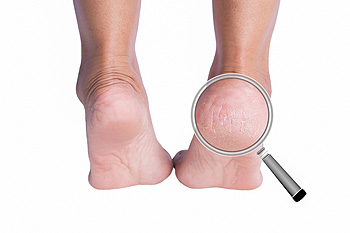
Heel fissures, also known as cracked heels, are a prevalent foot issue among adults, and they can be both painful and unsightly. These fissures appear as dry, flaky skin, and are often accompanied by deep, painful cracks on the heels. Several factors contribute to the development of heel fissures. One of the primary culprits is dry skin, typically caused by environmental conditions, such as low humidity or excessive heat, which can lead to the loss of natural skin moisture. Walking barefoot, particularly on hard surfaces, can also increase the risk of developing heel fissures. Additionally, underlying health conditions, like diabetes or thyroid disorders, can affect skin health, making individuals more susceptible to these conditions. If heel fissures become severe, it is suggested that you consult a podiatrist to rule out underlying health issues, in addition to receiving appropriate treatment options.
Cracked heels are unsightly and can cause further damage to your shoes and feet. If you have any concerns, contact one of our podiatrists from Foothill Podiatry Clinic. Our doctors can provide the care you need to keep you pain-free and on your feet.
Cracked Heels
Cracked heels appear unappealing and can make it harder for you walk around in sandals. Aside from looking unpleasant, cracked heels can also tear stockings, socks, and wear out your shoes. There are several methods to help restore a cracked heel and prevent further damage.
How Do You Get Them?
Dry skin is the number one culprit in creating cracked heels. Many athletes, walkers, joggers, and even swimmers suffer from cracked heels. Age and skin oil production play a role to getting cracked heels as well.
Promote Healing
Over the counter medicines can help, especially for those that need instant relief or who suffer from chronic dry feet.
Wear Socks – Wearing socks with medicated creams helps lock in moisture.
Moisturizers – Applying both day and night will help alleviate dryness which causes cracking.
Pumice Stones – These exfoliate and remove dead skin, which allows for smoother moisturizer application and better absorption into the skin.
Change in Diet
Eating healthy with a well-balanced diet will give the skin a fresh and radiant look. Your body responds to the kinds of food you ingest. Omega-3 fatty acids and zinc supplements can also revitalize skin tissue.
Most importantly, seek professional help if unsure how to proceed in treating cracked heels. A podiatrist will help you with any questions or information needed.
If you have any questions, please feel free to contact our office located in Grass Valley, CA . We offer the newest diagnostic and treatment technologies for all your foot care needs.
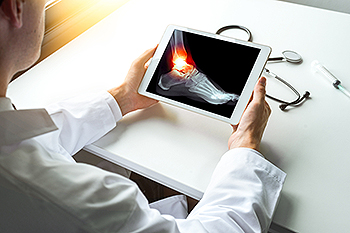
Managing a broken foot can be challenging, but understanding the healing process and recovery journey is important. Firstly, upon diagnosis, following a podiatrist's guidance regarding treatment is essential. Whether it is a cast, splint, or surgery, immobilizing the foot allows the bones to align and heal properly. Rest is paramount during the initial phase, in addition to minimizing weight-bearing and keeping the foot elevated to reduce swelling. As healing progresses, performing gentle exercises can help to regain strength, mobility, and flexibility. Recovery time varies depending on the severity of the break and individual healing capacity. On average, it can take several weeks to a few months to resume normal activities. Patience and adherence to medical advice is essential for a successful recovery, ensuring a strong foundation for a healthy foot. If you have broken your foot, it is strongly suggested that you seek the counsel of a podiatrist who can perform a proper diagnosis, and guide you toward the best treatment method for recovery.
A broken foot requires immediate medical attention and treatment. If you need your feet checked, contact one of our podiatrists from Foothill Podiatry Clinic. Our doctors can provide the care you need to keep you pain-free and on your feet.
Broken Foot Causes, Symptoms, and Treatment
A broken foot is caused by one of the bones in the foot typically breaking when bended, crushed, or stretched beyond its natural capabilities. Usually the location of the fracture indicates how the break occurred, whether it was through an object, fall, or any other type of injury.
Common Symptoms of Broken Feet:
Those that suspect they have a broken foot shoot seek urgent medical attention where a medical professional could diagnose the severity.
Treatment for broken bones varies depending on the cause, severity and location. Some will require the use of splints, casts or crutches while others could even involve surgery to repair the broken bones. Personal care includes the use of ice and keeping the foot stabilized and elevated.
If you have any questions please feel free to contact our office located in Grass Valley, CA . We offer the newest diagnostic and treatment technologies for all your foot and ankle needs.
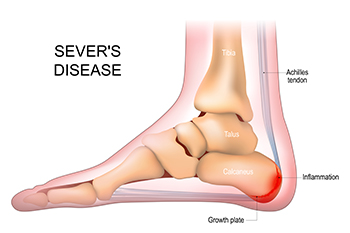
Sever's disease, also known as calcaneal apophysitis, is a common heel condition affecting children during growth spurts. The primary cause lies in the heel bone's growth plate, which is still developing and can become inflamed due to repetitive stress and tension. This often occurs in active children involved in sports or activities that involve a lot of running and jumping. The growth plate is more vulnerable during this period of rapid growth, making it susceptible to injury and irritation. The good news is that Sever's disease is manageable and typically resolves on its own as the growth plate solidifies. Treatment involves rest, modifying activities, stretching exercises, and wearing supportive footwear to alleviate symptoms and promote healing. If your active child has heel pain, which is a common symptom of Sever’s disease, it is suggested that you consult a podiatrist. This type of doctor can offer tailored treatment options for this condition.
Sever's disease often occurs in children and teens. If your child is experiencing foot or ankle pain, see one of our podiatrists from Foothill Podiatry Clinic. Our doctors can treat your child’s foot and ankle needs.
Sever’s Disease
Sever’s disease is also known as calcaneal apophysitis, which is a medical condition that causes heel pain I none or both feet. The disease is known to affect children between the ages of 8 and 14.
Sever’s disease occurs when part of the child’s heel known as the growth plate (calcaneal epiphysis) is attached to the Achilles tendon. This area can suffer injury when the muscles and tendons of the growing foot do not keep pace with bone growth. Therefore, the constant pain which one experiences at the back of the heel will make the child unable to put any weight on the heel. The child is then forced to walk on their toes.
Symptoms
Acute pain – Pain associated with Sever’s disease is usually felt in the heel when the child engages in physical activity such as walking, jumping and or running.
Highly active – Children who are very active are among the most susceptible in experiencing Sever’s disease, because of the stress and tension placed on their feet.
If you have any questions, please feel free to contact our office located in Grass Valley, CA . We offer the newest diagnostic and treatment technologies for all your foot and ankle injuries.
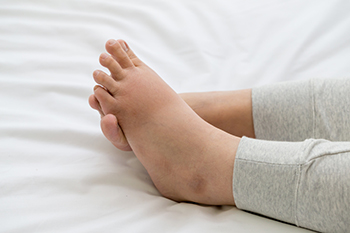
Pregnancy is a transformative journey filled with numerous physical changes, some of which can lead to aches and pains in the feet. These discomforts are often attributed to the body's natural adjustments to accommodate the growing baby. One common issue is swollen feet and ankles, caused by increased blood volume and pressure on leg veins. This can result in edema, a condition where excess fluid accumulates in the feet and ankles, causing swelling and discomfort. Another reason for foot pain during pregnancy is weight gain, which places added stress on the feet, leading to arch pain or plantar fasciitis. Hormonal changes during pregnancy can also affect ligaments and tendons, potentially causing instability and discomfort. To alleviate these discomforts, pregnant individuals are advised to wear supportive, comfortable shoes, and to elevate their feet whenever possible. Additionally, engaging in gentle foot exercises can help to improve circulation and flexibility. Understanding these common aches and pains can help expectant parents navigate this incredible journey with more comfort and confidence. If you would like more information about specific foot conditions during pregnancy, it is suggested that you consult with a podiatrist.
Pregnant women with swollen feet can be treated with a variety of different methods that are readily available. For more information about other cures for swollen feet during pregnancy, consult with one of our podiatrists from Foothill Podiatry Clinic. Our doctors will attend to all of your foot and ankle needs.
What Foot Problems Can Arise During Pregnancy?
One problem that can occur is overpronation, which occurs when the arch of the foot flattens and tends to roll inward. This can cause pain and discomfort in your heels while you’re walking or even just standing up, trying to support your baby.
Another problem is edema, or swelling in the extremities. This often affects the feet during pregnancy but tends to occur in the later stages.
How Can I Keep My Feet Healthy During Pregnancy?
If you have any questions please feel free to contact our office located in Grass Valley, CA . We offer the newest diagnostic and treatment technologies for all your foot and ankle needs.
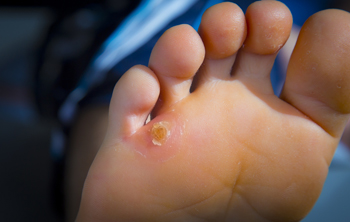
Corns on the feet can be a painful and frustrating problem. These small, hardened areas of skin can develop on the toes or bottom of the feet from friction or pressure. One cause of corns is wearing tight or improperly-fitted shoes, which can create constant friction on specific areas of the feet, leading to the formation of these painful skin growths. Also, individuals with foot deformities, such as bunions or hammertoes, may be more susceptible to developing corns. Frequent wearing of high heels, which shifts body weight toward the front of the foot and increases pressure on the toes, often results in corn development. Athletes or those engaged in activities that repeatedly stress the feet are also at a higher risk. Treatment of corns includes wearing comfortable, well-fitted shoes, using cushioned pads to alleviate pressure, and considering custom-made orthotic insoles to correct foot alignment. If a corn persists and causes discomfort, it is suggested that you make an appointment with a podiatrist. This foot doctor can safely remove a problematic corn and evaluate your feet to determine if custom orthotics may be needed in the future.
Corns can make walking very painful and should be treated immediately. If you have questions regarding your feet and ankles, contact one of our podiatrists of Foothill Podiatry Clinic. Our doctors will treat your foot and ankle needs.
Corns: What Are They? And How Do You Get Rid of Them?
Corns are thickened areas on the skin that can become painful. They are caused by excessive pressure and friction on the skin. Corns press into the deeper layers of the skin and are usually round in shape.
Ways to Prevent Corns
There are many ways to get rid of painful corns such as:
Treating Corns
Although most corns slowly disappear when the friction or pressure stops, this isn’t always the case. Consult with your podiatrist to determine the best treatment option for your case of corns.
If you have any questions please feel free to contact our office located in Grass Valley, CA . We offer the newest diagnostic and treatment technologies for all your foot and ankle needs.